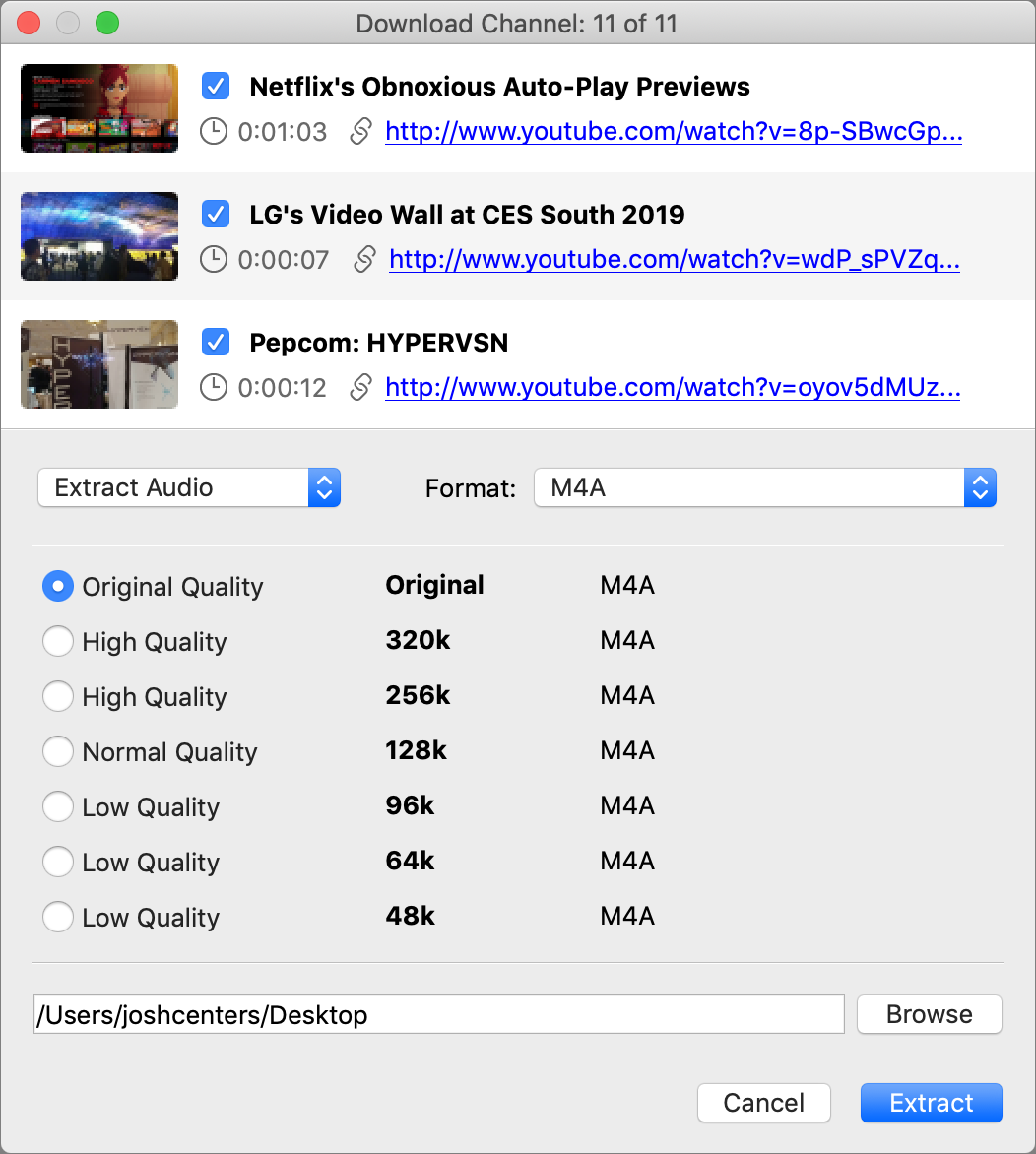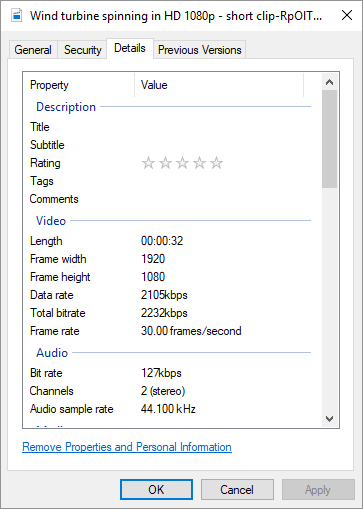How To Change Youtube-dl Download Directory Mac
- How To Change Youtube-dl Download Directory Macbook Pro
- How To Change Youtube-dl Download Directory Mac Pro
- How To Change Youtube-dl Download Directory
- How To Install Youtube Dl
When I reviewed the video player IINA (see “Prepare for Apple Dropping Old Media Formats with the IINA Video Player,” 6 May 2019), quite a few TidBITS readers took it as an opportunity to vent their frustrations about downloading videos from YouTube. Recent changes in Firefox have broken extensions like DownThemAll, which used to be a handy way to download videos.
There are several reasons you might want to download videos from YouTube. Like most cloud-based things, YouTube videos are ephemeral—they vanish all the time for all kinds of reasons. The uploader might pull a video down, YouTube may remove a video in response to a copyright complaint (sometimes legitimate, sometimes not), and a video might disappear if it runs afoul of YouTube’s ever-changing and seemingly haphazard standards for acceptable content.
- Could anyone give me a simple example of how to set the download destination directory? I think the -o is used but I can not see how to do it. It would be for windows system, please keep the example simple. Thank you sincerely.
- Navigate to the location where you want the files to be stored. Click the Select button. Click the Close button to exit Preferences. To download a specific image that appears on a web page, move your pointer over the image, right-click, and choose Save Image As from the pop-up menu that appears.

But preservation isn’t the only reason people download YouTube videos. For example, they may want to download short clips to use in their videos (honoring the doctrine of fair use, of course). A friend of mine accidentally deleted the “sizzle clip” he slaps on the front of every video in iMovie, and he solved the problem by downloading one of his own videos from YouTube and extracting that clip. Or, you may want to be able to play some YouTube videos in a situation where there’s no Internet access.
Above is a summary of the options, for a full list including network/proxy/filtering options, run youtube-dl -help. The files are downloaded to the current directory. 1) download youtube-dl and copy it to /usr/local/bin/ ( If /usr/local/bin does not already exist, then create it with sudo mkdir-p /usr/local/bin).
Whatever the reason, you don’t have to rely on Firefox to download videos from YouTube. There are several solutions on the Mac, and I review a few of them here.
Note that downloading YouTube videos with a utility other than YouTube’s apps (which require a YouTube Premium subscription) nominally violates YouTube’s terms of service:
You shall not download any Content unless you see a “download” or similar link displayed by YouTube on the Service for that Content. You shall not copy, reproduce, distribute, transmit, broadcast, display, sell, license, or otherwise exploit any Content for any other purposes without the prior written consent of YouTube or the respective licensors of the Content. YouTube and its licensors reserve all rights not expressly granted in and to the Service and the Content.
That said, I’ve never heard of YouTube punishing a user for downloading videos, although using copyrighted material in videos you upload to YouTube could get you in trouble.
The Command-Line Grand Poobah: youtube-dl
Arguably, the greatest of the YouTube downloaders is the public-domain youtube-dl, a command-line utility that powers many apps like the aforementioned IINA. It’s not the friendliest option, but it’s free and powerful.
The project offers instructions for installing youtube-dl. You can use the curl command or rely on Homebrew, a command-line package manager that I strongly recommend—refer to Homebrew’s home page for a one-line command to install it from Terminal. Then, in Terminal, you can enter brew install youtube-dl to install the download utility.
Once you install youtube-dl, type man youtube-dl in Terminal to see its extensive list of options. But all you really need to do to use it is to type youtube-dl URL in Terminal, where URL is the link to the desired YouTube video. That downloads the video in your current directory. Type cd ~/Downloads before running youtube-dl to download the video to your Downloads folder.
You can play the video after you download it with QuickTime or with a third-party player like IINA or VLC.
The developers of youtube-dl issue updates frequently, which is why I recommend installing it with Homebrew. The first time I tried to download a video for this article, I received an error because I hadn’t updated youtube-dl first. Homebrew makes updating easy with the brew update youtube-dl command, which updates both youtube-dl and Homebrew itself, along with all the packages youtube-dl needs to function.
A Free Graphical App: ClipGrab
ClipGrab is a simple, free utility for macOS that can download individual YouTube videos and even convert them to other formats, including MP3 if you’re only interested in the audio.
It’s easy to use: copy a YouTube URL and open ClipGrab. It will automatically extract the URL from the clipboard. Use the Format drop-down menu to choose a format (Original is usually fine if you want video), and click Grab This Clip to download the video. The default download location is your Desktop, but you can change it in the Settings tab.
ClipGrab offers a search tab where you can search for and download videos, but I find it easier to use YouTube’s search engine to find videos and then paste the URL into ClipGrab.
A Setapp Option: Downie
A subscription to Setapp includes several utilities that can download YouTube videos: the torrent client Folx, media players Movist Pro and Elmedia Player, and an app purpose-built for downloading YouTube videos: Downie. (If you’re not a Setapp subscriber, Downie costs $19.99.)
Downie, unlike ClipGrab, is tailor-made for the Mac. You can drag and drop YouTube URLs to Downie’s window or its Dock icon. Downie also comes bundled with a Safari extension, which you enable in Safari > Preferences > Extensions. Once you enable the extension, you can click the Downie icon in Safari’s toolbar to download a video.
In addition to Downie’s simplicity, I like that it downloads subtitles with the video (YouTube automatically generates subtitles for videos). Downie saves subtitles alongside the video as an SRT file. Unfortunately, QuickTime Player doesn’t understand those files, so you need to use a more capable video player like IINA to view them. As long as the SRT file is in the same directory as the video, it works automatically when you play the video in IINA.
Downie can also download an entire YouTube playlist at once. Just drag the playlist URL into Downie and click Playlist to see all the available videos to download. You can then click Add Selected to download the playlist videos.
Download an Entire Channel with 4K Video Downloader
How To Change Youtube-dl Download Directory Macbook Pro
Downie can download an entire playlist, but there’s only one Mac app that I know of that can download an entire YouTube channel: 4K Video Downloader. You can try the app for free (it costs $15 to unlock the entire app). To use it, copy the channel’s URL, open 4K Video Downloader, and click Paste Link to load every video in the channel.
Even better, when 4K Downloader is running, you can subscribe to a channel to download every new video published on the channel automatically.
Note that if a channel has a lot of videos, it can take a long time to download them all and it may use considerable system resources to do so. Nonetheless, I’ve successfully downloaded entire channels containing hundreds of videos with 4K Video Downloader, making it my favorite utility of the bunch.
4K Video Download can also download subtitles, and it can convert YouTube videos to MP3 audio files. Of course, it downloads individual videos as well.
There you have it: four utilities that you can use to download YouTube videos in macOS. Do you have another favorite? Let us know in the comments.
You can easily change the Downloads folder location on Mac OS X.

Why Move Downloads Folder?
There may be different reasons why people want to move their Downloads folder location.
These days many of the Apple Macs come with solid state drives (SSD) which are not as large in volume/capacity as the hard disk drives (HDD) used to be. For example, the standard Macbook Pro Retina comes with 256GB of SSD space. Some of that is used for the operating system and then you are left with very little for photos, downloads, files, apps, etc.
As a result of new Macs with smaller internal storage, you may want to move your Downloads folder to another volume such as an external drive, flash drive or SD card connected to your Mac. Yes, you can move your downloads folder permanently to another volume like this.
How To Move Mac OS Downloads Folder
Follow these steps to move your Downloads folder on Mac OS to another location:
1. Create New Downloads Folder
Go to the location where you want your new Downloads folder to be and create a folder named “Downloads“.
For example, I have an external drive plugged into USB where I want the Downloads folder to be. So I find my external drive in Finder and create a new “Downloads” folder there.
How To Change Youtube-dl Download Directory Mac Pro
2. Copy Existing Downloads Over
If you want to keep your existing downloads, you’ll need to copy it over.

Simply use the Finder app to drag and drop the contents of the existing Downloads folder to the new Downloads folder.
3. Delete Old/Default Downloads Folder
In order to create a symbolic link in step 4 below, you’ll need to delete the old/default Downloads folder in Mac OS. It may not be possible to delete the old/default Downloads folder in Finder directly due to permissions on the folder so you’re better off doing it in the Terminal using sudo command.
Open the Terminal app and type the following command followed by your password for your account:
Note that this deletes your old/default Downloads folder with all it’s contents.
4. Create Symbolic Link
Next you’ll create a symbolic link from the default Downloads folder in Mac OS to the new one in the other location.
Open the Terminal and type the following command:
How To Change Youtube-dl Download Directory
Note that command creates a link (ln command) between a target and source directory. The -sparameter creates a symbolic link.
Be sure to change /Volumes/My Passport 1/Downloads/with the absolute path to your new Downloads folder you created in the new location. In my case, Mac OS gave my external drive the path /Volumes/My Passport 1/and then I add the /Downloads/part to the path in the command. The backslashes in the path is simply to escape the spaces in the folder name of the external drive.
If you’re not sure what the path to the new location is and you’re using either an internal or external storage, you can use the Disk Utility app in Mac OS to determine the mount point.
Mac OS Downloads Folder Moved!
That’s it, you’re all done moving your Mac OS Downloads folder.
How To Install Youtube Dl
The symbolic link you created in step 4 will ensure that any applications putting downloads in the old location ~/Downloadswill go to the new Downloads folder in the new location so that you don’t have to go and edit the Downloads folder in individual applications.